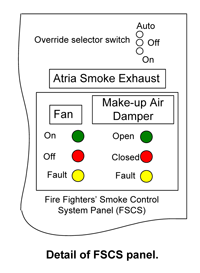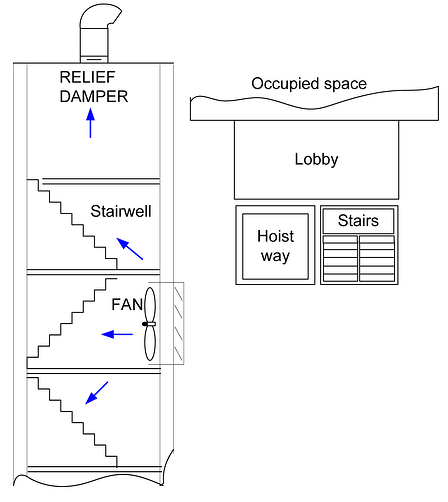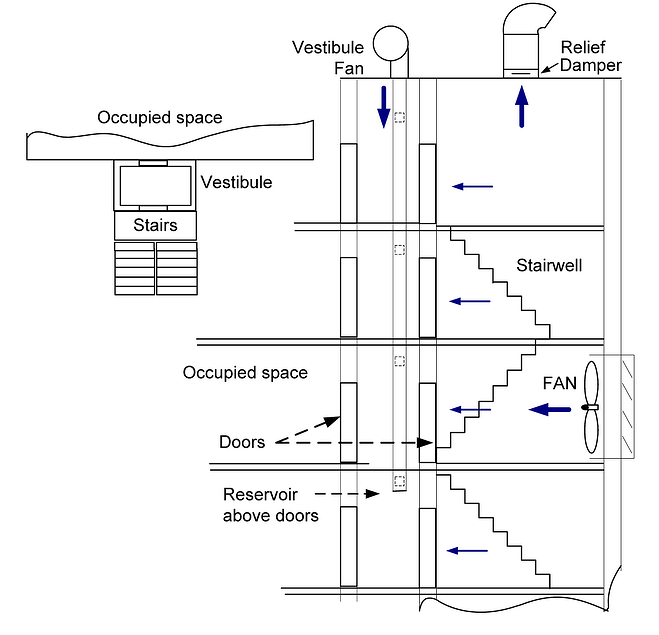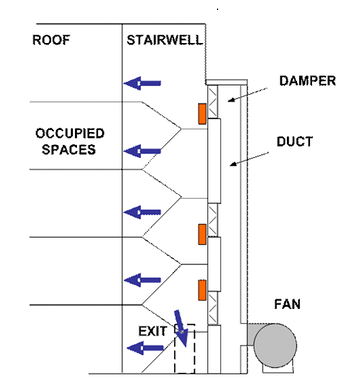A Comprehensive Look at Engineered Smoke Control Systems
Smoke control systems use any and all methods possible to protect from smoke spread. Doors, fans, sprinklers, dampers, and alarms are unified into one coordinated system. Coordination of all the smoke control tactics is typically performed by a fire alarm/smoke control panel. In most systems, fire fighters have override control from a Fire Fighters’ Smoke Control System (FSCS) Panel located in a lobby or a protected area. Overrides and status indication of all equipment are present on the face of the FSCS or a computer screen display. Figure to the left shows a detail of a typical override switch and indicator lights on a FSCS panel.
spread. Doors, fans, sprinklers, dampers, and alarms are unified into one coordinated system. Coordination of all the smoke control tactics is typically performed by a fire alarm/smoke control panel. In most systems, fire fighters have override control from a Fire Fighters’ Smoke Control System (FSCS) Panel located in a lobby or a protected area. Overrides and status indication of all equipment are present on the face of the FSCS or a computer screen display. Figure to the left shows a detail of a typical override switch and indicator lights on a FSCS panel. Figure 1: Relief damper variation of stairwell pressurization.
Figure 1: Relief damper variation of stairwell pressurization.
Stairwell pressurization
Stairwell pressurization can be accomplished a number of ways. The IBC (IBC. 2012) requires vestibules in unsprinklered buildings. This can be supplemented with stairwell pressurization. In sprinklered buildings pressurization alone is allowed. One should consult the IBC for details of requirements.
One method uses a constant volume fan capable of pushing air through any stair door that opens. A barometric damper in the stairwell roof or wall relieves excessive pressure. See Figure 1. In Figure 2 a combination vestibule with barometric is shown. There are designs by different fire protection engineers that use lobbies under positive pressure and others using negative pressure (IBC method) by exhausting. For the most part these designs do not use automated dampers in the periphery.
Since most buildings are sprinklered, pressurization systems alone are more common. A duct system can be run the height of the stairwell and proportional actuated dampers located every few floors with local pressure sensors. If a floor door opens, the damper(s) nearest it modulate(s) open as necessary to maintain pressure. A certain amount of smoke may enter the stairwell when any door is opened if there is a lot of pressure behind it. Typically, the expansion of heated air does provide pressure. It takes some time for the sensor, controller, and actuator to respond and open the local dampers further. See Figure 3. The fan may be controlled by a VFD for better control.
Other variations are possible and research is incomplete with regards to which is best in what geometric arrangement of stairs, stack effect, or height of stairs. One variation is a second fan that turns on when the egress level door is opened. Then that door does not relieve all the pressure necessary for the floors. Some research has shown that sufficient ventilation alone during a fire will keep the stairwell tenable. This employs a supply fan at the bottom of the stairwell and an exhaust fan at the top. It can be combined with door pressurization by using variable frequency drive (VFD) fans.

Figure 2: Vestibule variation and supplemental stairwell pressurization

Figure 3: Stairwell pressurization system using proportional damper control.
Stairwells are built to be smoke proof compartments. The occupants can escape into the stairwells and be protected from smoke while they escape the building. When floor doors are opened, smoke must not enter the stairwell. Since several architectural and control design methods are used examination of each system is necessary to understand its intent. Testing using smoke generators helps to ensure the system works as required. Pressure in the stairwell must be below that which would hinder the opening of doors.
